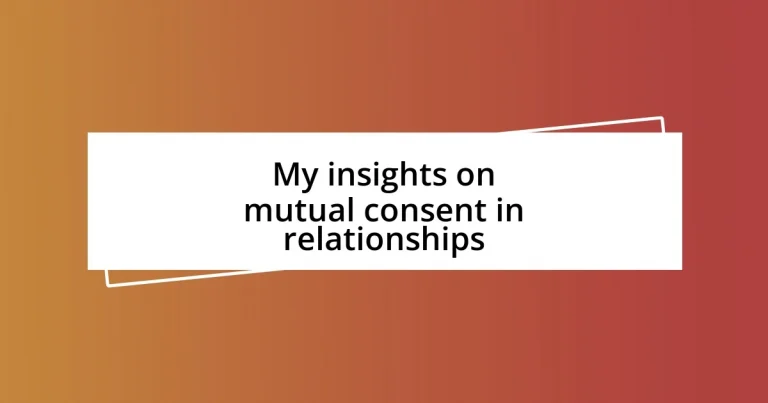Key takeaways:
- Mutual consent is essential for a healthy relationship, fostering trust and empowering open communication about boundaries and desires.
- Challenges to mutual consent include miscommunication, differing expectations, and emotional vulnerability, all of which require honest discussions to overcome.
- Practicing mutual consent involves regular check-ins, vulnerability in communication, and being attentive to both verbal and nonverbal cues to ensure both partners feel valued and respected.
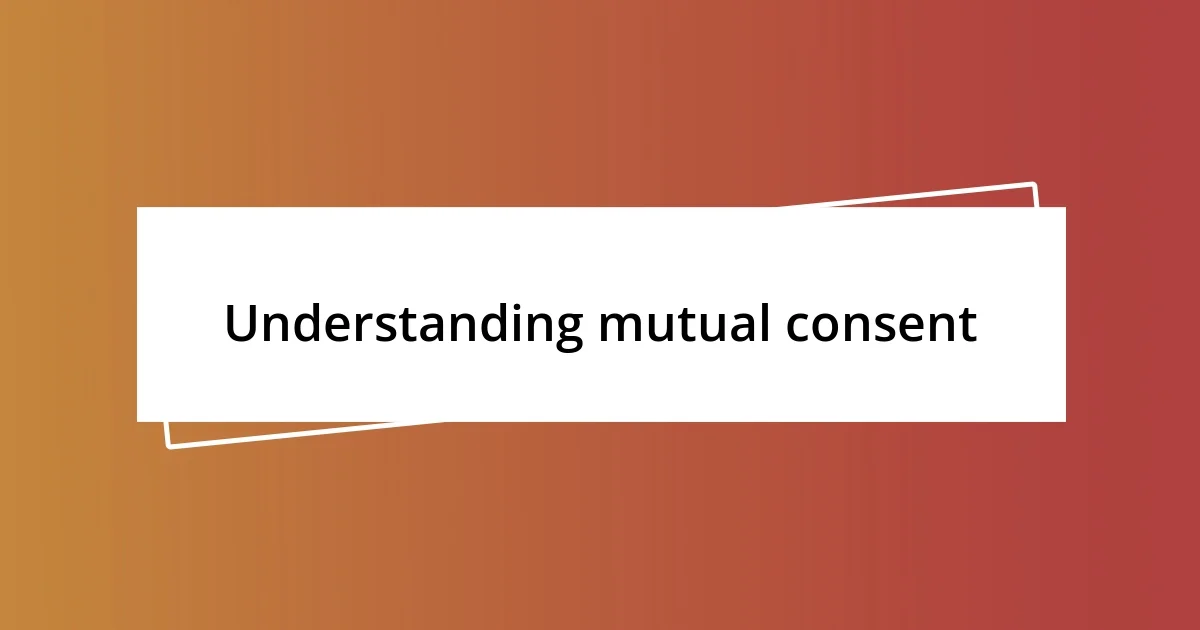
Understanding mutual consent
Mutual consent is the foundation of any healthy relationship. It’s more than just agreeing to something; it’s a shared understanding and respect for each other’s choices. I remember a time when I realized how crucial this was during a conversation with a close friend. We discovered that the willingness to openly discuss our boundaries deepened our connection and trust.
I’ve noticed that many people mistake compliance for consent, but there’s a significant difference. Consent must be enthusiastic and ongoing, not just a “yes” in the moment. Think about your own experiences—have you ever felt pressured into agreeing to something you weren’t completely comfortable with? That nagging feeling afterward often stems from a lack of genuine consent, highlighting why ongoing dialogue is so essential in relationships.
When both partners feel empowered to express their desires and boundaries, the relationship flourishes. I’ve seen how checking in with each other can transform not just intimate moments but everyday interactions as well. It’s empowering for both parties to ask, “Is this still okay?” or “How do you feel about this?” This simple question can foster a deeper emotional bond and promote mutual understanding, ensuring both partners feel valued and respected.
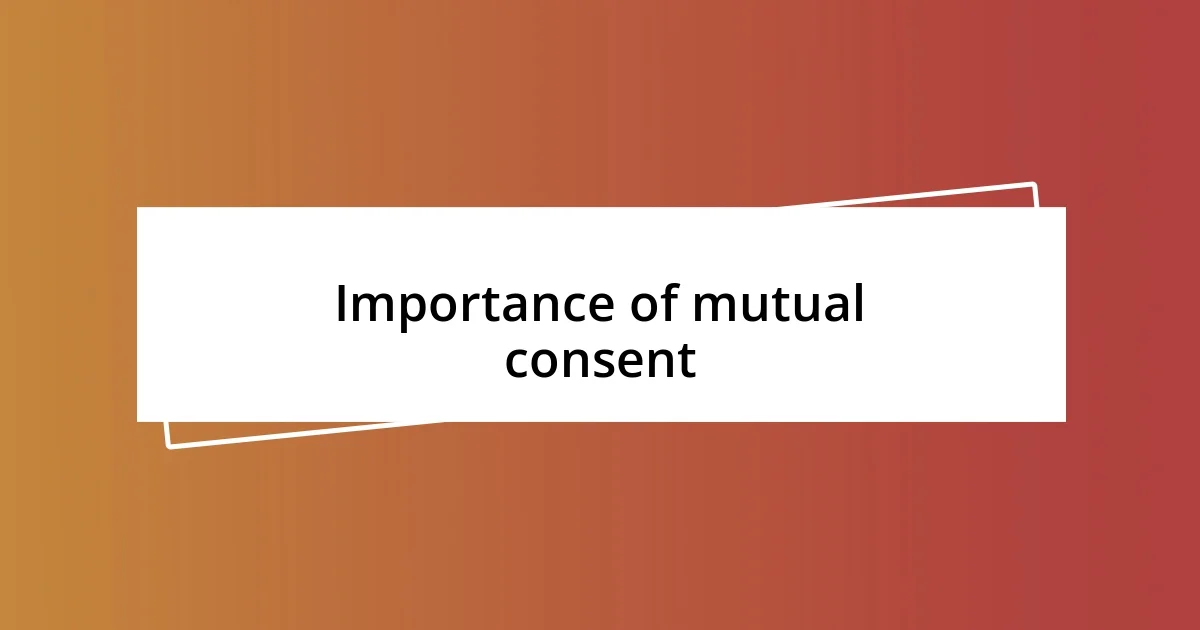
Importance of mutual consent
Mutual consent is not just a legal requirement; it’s a vital component that strengthens the emotional fabric of a relationship. I recall a moment in my own romantic life when my partner and I navigated a sensitive topic together. By openly discussing our thoughts and feelings, we built a bridge of understanding that made us both feel safe and appreciated. That experience taught me that consent fosters trust, allowing partners to explore their connection without fear or hesitation.
Recognizing the importance of mutual consent can lead to transformative experiences in relationships. Here are a few key points to consider:
- Empowered Communication: Mutual consent encourages open discussions where both partners can voice their needs and expectations.
- Enhancing Trust: When consent is prioritized, it reinforces trust, allowing for greater vulnerability and intimacy.
- Promoting Equality: Emphasizing mutual consent fosters a balanced partnership where both individuals feel equally valued and heard.
- Minimizing Regret: Genuine consent can help prevent discomfort and regret, making sure that both partners are fully onboard in their decisions.
Reflecting on these points can spark valuable conversations and lead to richer, more meaningful connections.
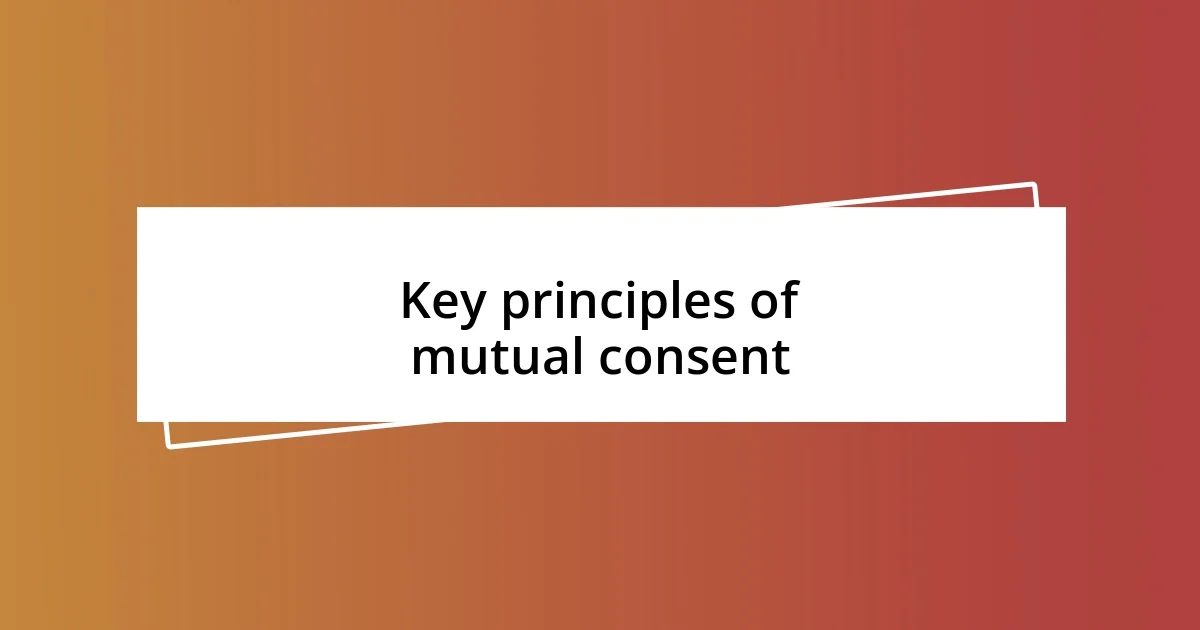
Key principles of mutual consent
Understanding the key principles of mutual consent can dramatically shift the dynamics of a relationship. For me, it’s about recognizing not just the need for agreement, but the whole atmosphere that surrounds it. I remember a time during a discussion with my partner about future plans. The connection we created through our shared decisions felt so genuine; it highlighted how important it is for both individuals to feel equally involved and respected.
Another crucial element is the recognition that consent isn’t a one-time agreement. It creates an ongoing dialogue where both partners feel safe to articulate their feelings and preferences. I’ve had moments where my partner and I would check in with each other, like asking, “Are you comfortable with this direction we’re heading?” Those small inquiries opened the door for deeper discussions and showcased how dynamic consent truly is in nurturing a trusting environment.
Lastly, I’ve found that mutual consent also involves giving and receiving feedback. My experiences have shown me that when we allow space for honest reflections—both positive and constructive—it strengthens not just the relationship, but also our individual selves. By committing to regularly revisit our understandings, we foster an atmosphere of support where growth is not only possible but celebrated.
| Key Principle | Explanation |
|---|---|
| Ongoing Dialogue | Consent is a continuous conversation, not a one-time agreement. |
| Mutual Respect | Both partners’ feelings and boundaries are acknowledged and valued, fostering equality. |
| Empathetic Feedback | Constructive exchange of thoughts enhances both partners’ individual and mutual growth. |
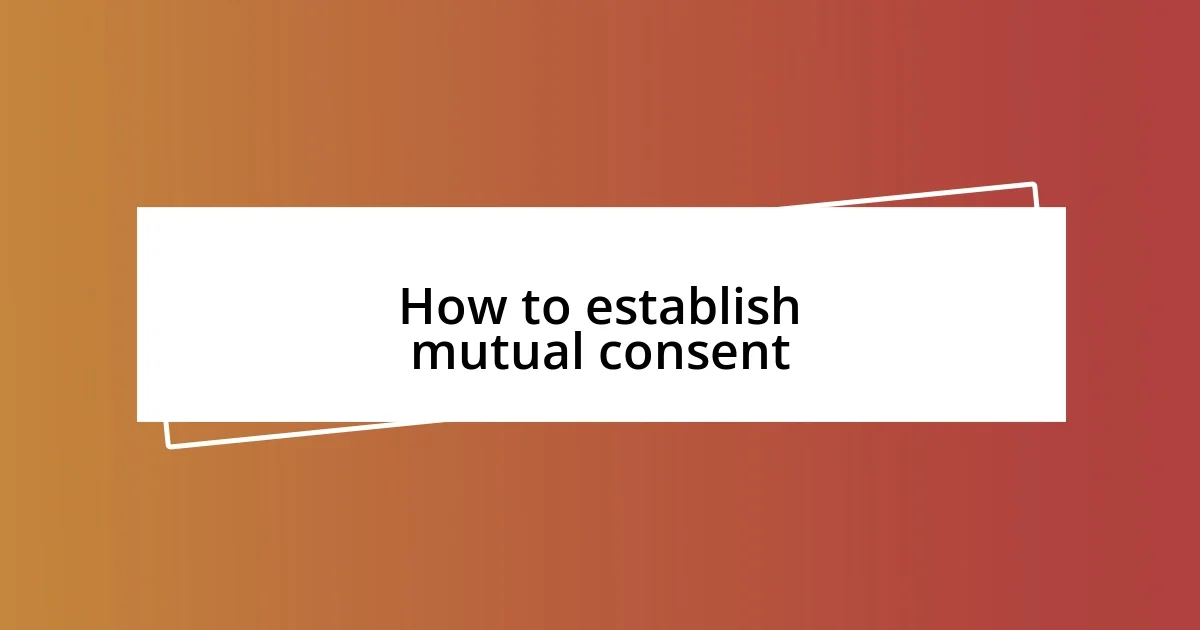
How to establish mutual consent
To establish mutual consent in a relationship, I think it’s essential to create an open atmosphere where both partners genuinely feel comfortable sharing their thoughts. One time, my partner and I decided to set aside an hour every week for a “check-in.” This turned into a sacred time where we poured out feelings, needs, and even our unfiltered fears. It amazed me how just being vulnerable could deepen our bond and reveal layers of understanding.
Another crucial step is actively listening. When my partner shares something, I ask questions that reflect what I’m absorbing, like, “Can you tell me more about how that makes you feel?” This simple act doesn’t just affirm their feelings; it shows that their perspective matters to me. I’ve learned that consent thrives in environments where each person feels heard and validated, which makes a tremendous difference in the level of trust.
Finally, I believe that practicing consent extends beyond verbal agreements. Recently, I realized that just as important as discussing big decisions is the need to check in during everyday moments. Whether it’s a spontaneous outing or a shift in plans, asking “Is this still good for you?” goes a long way. It might seem small, but this habit reinforces our shared commitment to a respectful partnership and continually nurtures the trust between us.
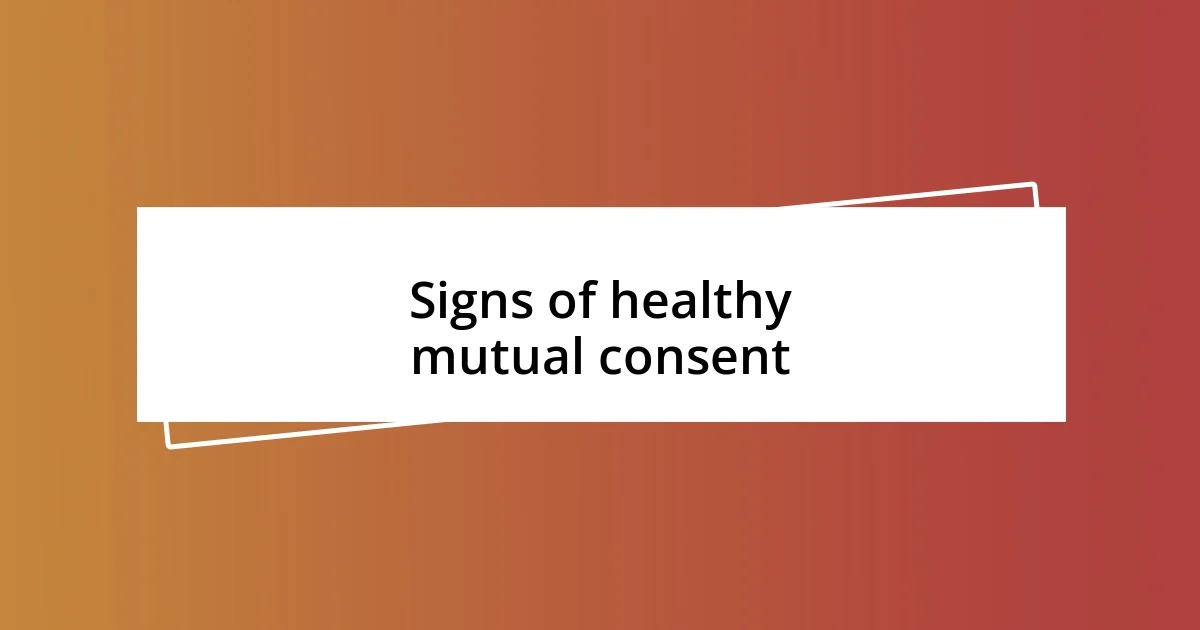
Signs of healthy mutual consent
One of the key signs of healthy mutual consent is when both partners willingly share their boundaries and feelings without fear of judgment. I remember a moment when I felt hesitant about expressing a specific concern. But when I did, my partner’s receptive response showed me that our relationship was built on a foundation where both of us could voice our worries openly. It’s vital—how can we nurture a relationship if we don’t feel safe to speak our truth?
Another unmistakable sign is the presence of active listening. I can think of a time when we were discussing plans for our weekend. Instead of just making choices, we took turns sharing our thoughts on what energizes or drains us. This back-and-forth not only clarified our desires but reinforced our connection. It made me realize that true consent isn’t merely about agreeing; it’s about being present and engaged with each other, creating a rhythm that reflects our unique dynamic.
Lastly, mutual enthusiasm in decisions serves as a clear indicator of healthy consent. There have been instances when my partner and I faced choices, but instead of merely compromising, we found options that excited both of us. We often ask each other, “What excites you about this idea?” If the spark is lacking for one of us, we pivot together. This experience has taught me that consent flourishes when both individuals feel not just heard, but also energized by the choices they make together.
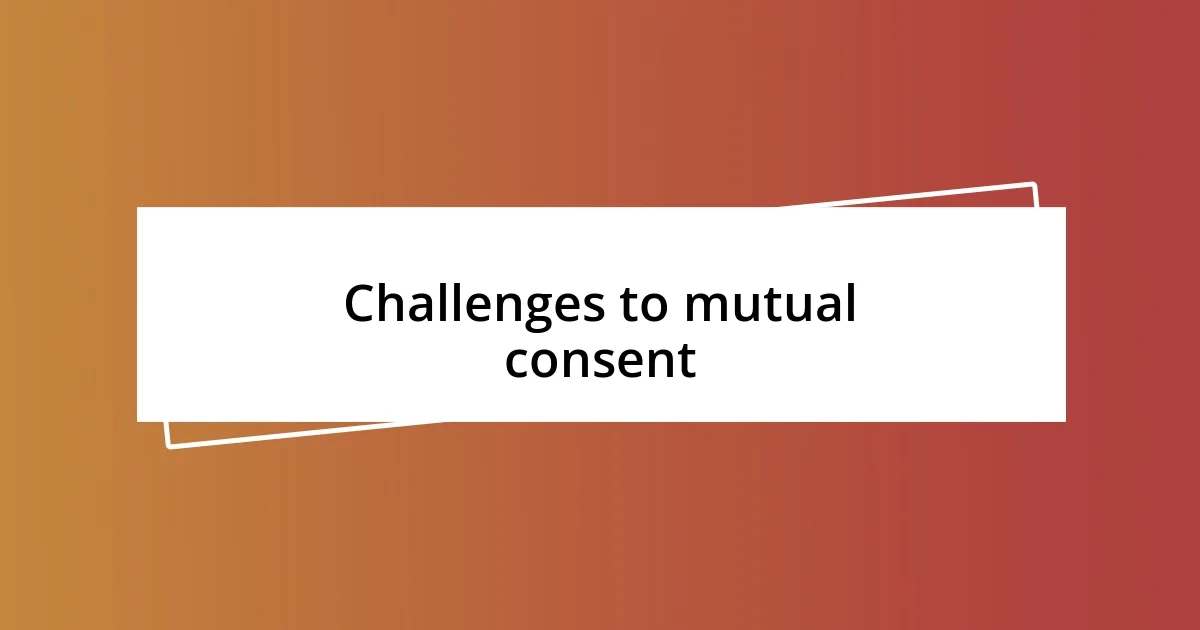
Challenges to mutual consent
Navigating mutual consent often encounters significant challenges, and one of the most common hurdles is miscommunication. There was a time when I assumed my partner understood my feelings about a particular situation, but that wasn’t the case. It led to tension, leaving me wondering, “Why didn’t I express myself more clearly?” This experience made me realize that even small misunderstandings can undermine consent and trust.
Another challenge arises from differing expectations. I remember planning a vacation, and my partner envisioned a jam-packed itinerary, while I craved a relaxed getaway. When I reflected on our discussions, I realized I hadn’t conveyed how vital downtime was for me. This dissonance made me think: how can we achieve mutual consent if we’re not on the same page about our needs? Finding ways to align expectations is crucial, as it fosters a sense of partnership and shared vision.
Lastly, emotional vulnerability can be a barrier to mutual consent. Many times, I’ve felt hesitant to bring up uncomfortable topics, fearing they might disrupt our harmony. But I’ve come to understand that genuine consent requires an openness to discuss even the tough stuff. It begs the question: what’s the point of consent if we’re only willing to scratch the surface? Embracing the discomfort can lead to deeper understanding and ultimately strengthen our bond.
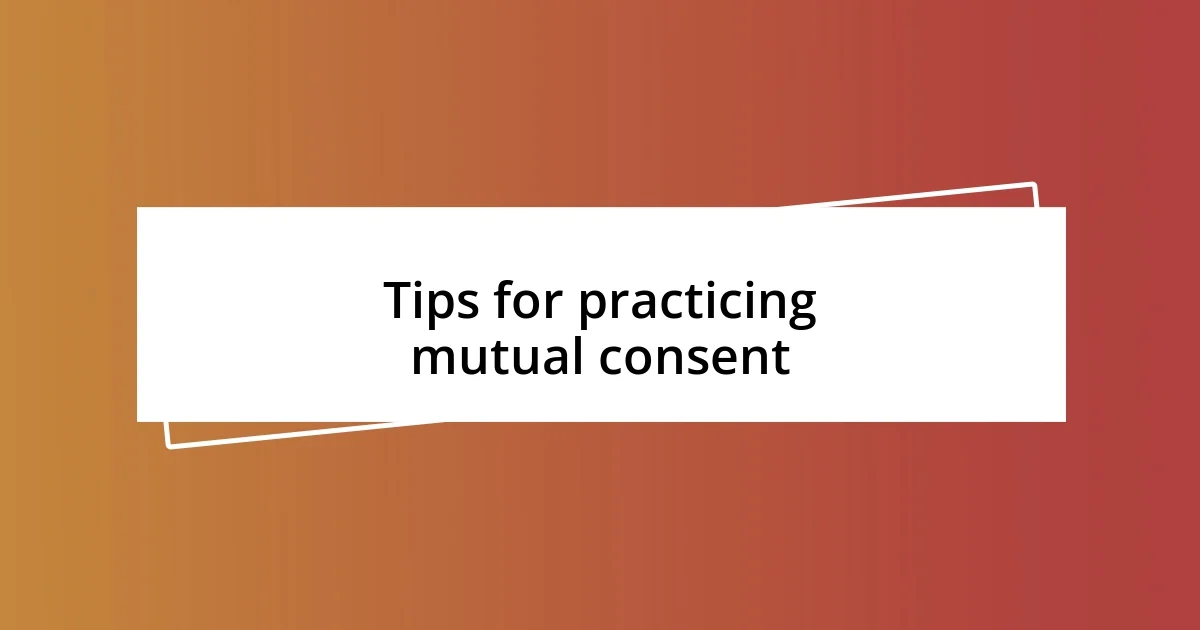
Tips for practicing mutual consent
When practicing mutual consent, the first step is to cultivate a habit of regular check-ins. I can recall an eye-opening conversation with a friend who suggested we sit down weekly to discuss how we were feeling in our friendships. This practice made it easier for us to navigate our emotions and establish a deeper understanding of each other’s perspectives. Have you ever felt that simply talking through your thoughts can enhance transparency and trust? It works wonders!
Another important tip is to practice being vulnerable in your communications. I remember a time when I hesitated to share my fears about a change in my relationship dynamic. Once I finally opened up, my partner responded with similar honesty. That moment solidified our connection and made it easier to face future conversations together. Isn’t it fascinating how vulnerability can build bridges rather than create gaps?
Finally, don’t underestimate the power of body language. I often find myself observing how my partner’s nonverbal cues align with their verbal communication. There was a situation where I noticed my partner seemed off while we were discussing a sensitive topic. Instead of pushing forward, I asked them what was on their mind, leading to a much-needed dialogue. Remember, consent isn’t just spoken; it’s felt too. How attuned are you to the unspoken messages in your conversations?











